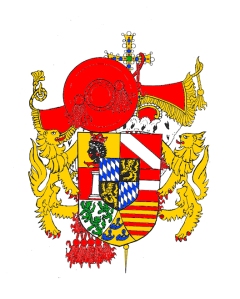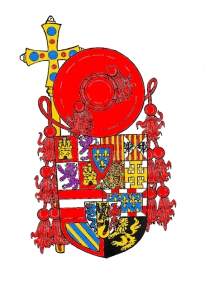Since these have been so well received I thought I would share some more of my favorites from among those Cardinals of the Holy Roman Church who were from well known armigerous and noble aristocratic families.
First we see the arms of Johann Theodor Cardinal Wittelsbach von Bayern, Cardinal Priest of S. Lorenzo in Panisperna. He was created cardinal “in pectore” in 1743 and proclaimed in 1746. He was also Prince-Bishop of Liège, Friesing & Regensburg. The arms are:
Quarterly of six; 1 (Friesing) Or a moor’s head Sable couped at the neck crowned and collared Gules, 2 (Regensburg) Gules a bend Argent, 3 to 6 (Liège) Gules a column Argent, Gules a fess Argent, Argent three lions rampant vert, Barry Or and Gules a point in point Or three hunting horns Azure; Overall on an escutcheon Bavaria (fussily in bend Argent and Azure) quartering Palatinate (Sable a lion rampant Or). The supporters are two lions Or.
Next are the arms of Luis Antonio Jaime de Borbón y Farnesio, de Baviera y d’Este who was born the youngest son of King Philip V, King of Spain, and his second wife, Elizabeth Farnese. While barely eight years of age, Luis was created 699th Knight of the Order of the Golden Fleece in 1735 and ordained Archbishop of Toledo and Primate of Spain on 9 September 1735, and subsequently named Cardinal Deacon of the Title of the church of Santa Maria della Scala in Rome on 19 December. On 18 December 1754 he abandoned the ecclesiastical life for lack of vocation, renounced his ecclesiastical titles and dignities and assumed the title of 13th Conde de Chinchón granted by his brother Infante Felipe.
When his older half-brother King Ferdinand VI died without issue in 1759, Luis claimed the throne on the grounds that, he was the only surviving son of Philip V who was born in Spain, and the only one still residing in Spain (his older brothers were Charles, King of Naples and Sicily, and Philip, Duke of Parma, both reigning in Italy). However valid his claim, Luis lost the succession to his oldest brother Charles, while Charles’ third son became Ferdinand I of the Two Sicilies.
The arms are: Quarterly 1: (Castile) Gules a triple towered castle Or quartering (Leon) Argent a lion rampant Purpure; 2: (Argaon) Or five pallets Gules impaling (Sicily) Per saltire Aragon and Argent two eagles in fess displayed Sable; a point in point between the two quarters of (Granada) Argent a pomegranate Proper; 3: Per fess (Austria) Gules a fess Argent and (Burgundy ancient) bendy Or and Azure, a border Gules; 4: Per fess (Burgundy modern) Azure, semeé de lis Or, a border compony Argent and Gules and (Brabant) Sable a lion rampant Or; two inescutcheon in pale the first (Bourbon) Azure three fleurs-de-lis Or, a bordure Gules; the second tierces in pale (Visconti) Argent a viper vorant Azure crowned Or and devouring a child Gules; (Flanders) Or a lion rampant Sable membered Gules, And (Tyrol) Argent, an eagle displayed Gules.
This cardinal, because of his failed claim to the throne, could also be numbered among the “royal” cardinals as well.
(artwork by the late Michael McCarthy)


Does Beniamion Stella have a coat of arms?
Argaon = Aragon and four pales surely, not five ‘
Yes. Four. A typo. But they are pallets, not pales.
If they were British arms possibly, but the law refers to “palos” (where the diminutive would have been possible but
they have avoided it) :- Escudo cuartelado en cruz: Primer cuartel, sobre campo de oro, una encina desarraigada, con siete raigones, en sus colores naturales, coronada por cruz latina cortada y de gules. Segundo, sobre campo de azur, cruz patada de plata, apuntada en el brazo inferior y adiestrada en el cantón del jefe. Tercero, sobre campo de plata, una cruz de San Jorge, de gules, cantonada de cuatro cabezas de moro, de sable y encintadas de plata. Cuarto, sobre campo de oro, cuatro palos gules iguales entre sí y a los espacios del campo. Todo el escudo, timbrado de corona real abierta de ocho florones, cuatro de ellos visibles, con perlas, y ocho flores de lis, cinco visibles, con rubíes y esmeraldas en el aro, en proporción con el escudo de dos y medio a seis.
Ley 2/1984, de 16 de abril, art. 4º pub. en B.O.A. n.º 5, 18 de abril de 1984.
Aragon is still misspelt.
No, it has nothing to do with the arms being British or Spanish or Martian. A pale is a vertical ordinary division that takes up one third of the field. The smaller vertical subordinaries are pallets because they are smaller than pales. To call them pales would be like referring to a bar or barrulet as a fess.
I have not gone back to change the text at all. These comments suffice as correction. And you misspelled misspelt.